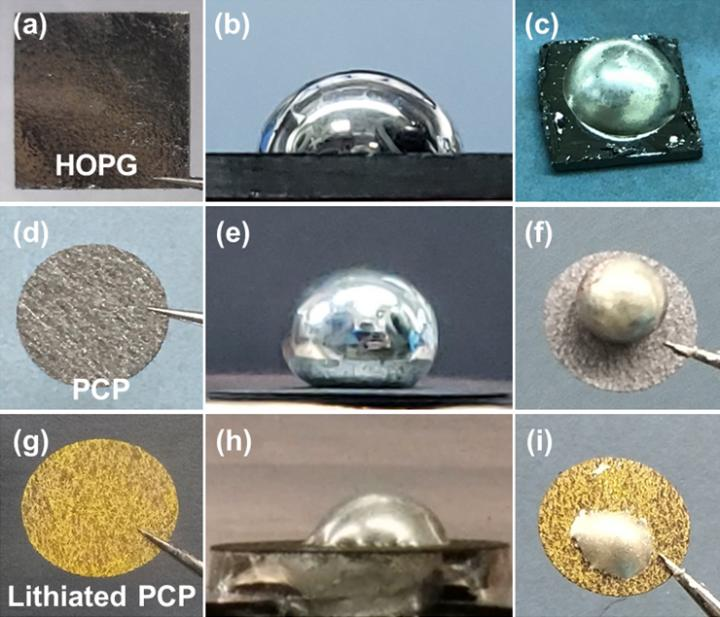Mar 11 2020
The late 1970s saw the discovery of the “Rock-chair” Li-ion battery (LIB), which was later commercialized by Sony in 1991. This battery has become the preferred mode of storing portable energy nowadays.
 Contact angle experiments of Li metal and graphite materials: (a-c) highly oriented pyrolytic graphite (HOPG); (d-f) porous carbon paper (PCP); (g-i) lithiated porous carbon paper (lithiated PCP). Image Credit: ©Science China Press.
Contact angle experiments of Li metal and graphite materials: (a-c) highly oriented pyrolytic graphite (HOPG); (d-f) porous carbon paper (PCP); (g-i) lithiated porous carbon paper (lithiated PCP). Image Credit: ©Science China Press.
The 2019 Nobel Prize in chemistry was given to three well-known researchers (John B. Goodenough, M. Stanley Whittingham, and Akira Yoshino) to acknowledge their contribution in “creating a rechargeable world.” These Nobel laureates made the most significant contributions in discovering LIBs.
But this technology is approaching its practical performance limits, and comprehensive efforts are being made to substitute LIBs with the latest electrochemical storage solutions which are stable, secure, and economical, and have higher energy density to drive long-lasting portable electronics and long-range electric vehicles.
Using Li metal—a “holy” anode with a high theoretical capacity of 3860 mAh/g—in the place of conventional graphite-based anodes could be a promising method. Currently, Li metal anodes experience infinite volume change and poor cycling efficiency, raising concerns relating to operational safety.
Effective measures, such as artificial solid-electrolyte interface, functional electrolyte additive, and the use of host scaffolds to buffer the volume expansion have been taken to deal with its drawbacks. Among these three methods, the use of scaffolds continues to witness rapid development.
The classic Li anode, graphite, has high electron conductivity and is low-density, making it a promising and effective host scaffold. But Li metal is known to wet graphite poorly, rendering it difficult to spread and infiltrate.
Earlier techniques of converting graphite from lithiophobicity to lithiophilicity include surface coating with Ag, Si, or metal oxide. Lithiophobicity denotes a large contact angle, whereas lithiophilicity denotes a low contact angle between a solid surface and molten lithium.
But such a variation in liquid spreading behavior is caused by the substitution of graphite by reactive coating. As a result, it might be questioned whether graphite is intrinsically lithiophilic or lithiophobic.
In this study, the wetting behavior of molten Li on varied types of carbon materials based on graphite was methodically studied. Initially, the highly oriented pyrolytic graphite (HOPG) was utilized as the test sample. It was seen that the HOPG substrate instantly enables a contact angle (CA) of 73° with Li metal.
To verify this practical experiment against theory, ab initio molecular dynamics simulation was carried out with a molten Li droplet (54 Li atoms)/graphite (432 C atoms, two-layered graphene). The simulation was set up to demonstrate that the graphite’s clean (002) surface is intrinsically lithiophilic at 500 K and the results also validated that graphite and lithium have an excellent affinity.
But the CA of Li metal on porous carbon paper is as high as 142°, denoting that PCP is lithiophobic. This outcome, which challenged the earlier conclusion that graphite is intrinsically lithiophilic, motivated scientists to gain a better understanding of the impact of surface chemistry on the wetting performance of graphite and Li metal.
In comparison to HOPG, it was discovered that a large number of oxygen-containing functional groups are present on the PCP surface. Such surface impurities have a vital role to play in pinning the contact line between PCP and Li metal and thus lead to a bigger apparent contact angle.
To illustrate this assumption, the PCP was initially lithiated by reducing its electrochemical potential with molten Li metal. At the time of this process, PCP’s surface impurities will also be removed.
The next experiment demonstrated that lithiated PCP displayed a slight CA of ~52°, which denoted an effective conversion of lithiophobicity to lithiophilicity. The porous structure of the lithiated PCP enables the Li metal to diffuse through rapidly.
The DFT simulation exposed that graphite and lithiated graphite had analogous wetting performance, proving that the removal of surface impurities would be the main reason for this conversion of wetting performance from PCP to lithiated PCP. Moreover, the graphite powder is utilized to test its wettability with Li metal. After the graphite powder is mixed continuously, it can be evenly dispersed in the Li metal matrix, additionally confirming the graphite’s lithiophilic property.
Leveraging this discovery, an innovative Li metal-graphite compositing technique was proposed, making it possible to produce large-area Li-graphite composite anode at a commercial level.
The study methodically examines the wettability of graphite-based carbon materials and Li metal and also offers a new concept for developing Li-carbon composite anode materials, which are useful for developing high-energy Li metal batteries.